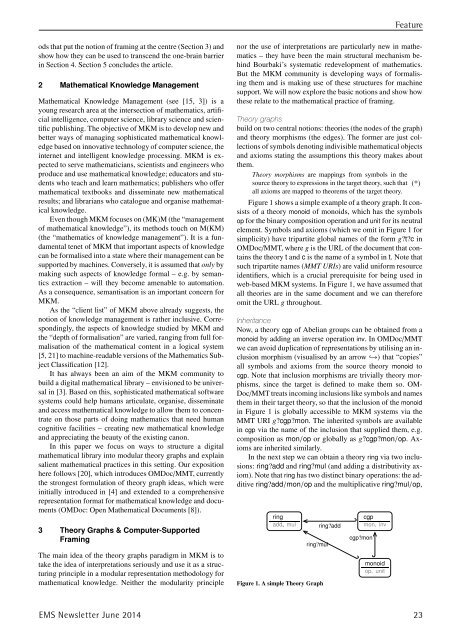1mZ2hsN
1mZ2hsN
1mZ2hsN
Create successful ePaper yourself
Turn your PDF publications into a flip-book with our unique Google optimized e-Paper software.
Featureods that put the notion of framing at the centre (Section 3) andshow how they can be used to transcend the one-brain barrierin Section 4. Section 5 concludes the article.2 Mathematical Knowledge ManagementMathematical Knowledge Management (see [15, 3]) is ayoung research area at the intersection of mathematics, artificialintelligence, computer science, library science and scientificpublishing. The objective of MKM is to develop new andbetter ways of managing sophisticated mathematical knowledgebased on innovative technology of computer science, theinternet and intelligent knowledge processing. MKM is expectedto serve mathematicians, scientists and engineers whoproduce and use mathematical knowledge; educators and studentswho teach and learn mathematics; publishers who offermathematical textbooks and disseminate new mathematicalresults; and librarians who catalogue and organise mathematicalknowledge.Even though MKM focuses on (MK)M (the “managementof mathematical knowledge”), its methods touch on M(KM)(the “mathematics of knowledge management”). It is a fundamentaltenet of MKM that important aspects of knowledgecan be formalised into a state where their management can besupported by machines. Conversely, it is assumed that only bymaking such aspects of knowledge formal – e.g. by semanticsextraction – will they become amenable to automation.As a consequence, semantisation is an important concern forMKM.As the “client list” of MKM above already suggests, thenotion of knowledge management is rather inclusive. Correspondingly,the aspects of knowledge studied by MKM andthe “depth of formalisation” are varied, ranging from full formalisationof the mathematical content in a logical system[5, 21] to machine-readable versions of the Mathematics SubjectClassification [12].It has always been an aim of the MKM community tobuild a digital mathematical library – envisioned to be universalin [3]. Based on this, sophisticated mathematical softwaresystems could help humans articulate, organise, disseminateand access mathematical knowledge to allow them to concentrateon those parts of doing mathematics that need humancognitive facilities – creating new mathematical knowledgeand appreciating the beauty of the existing canon.In this paper we focus on ways to structure a digitalmathematical library into modular theory graphs and explainsalient mathematical practices in this setting. Our expositionhere follows [20], which introduces OMDoc/MMT, currentlythe strongest formulation of theory graph ideas, which wereinitially introduced in [4] and extended to a comprehensiverepresentation format for mathematical knowledge and documents(OMDoc: Open Mathematical Documents [8]).3 Theory Graphs & Computer-SupportedFramingThe main idea of the theory graphs paradigm in MKM is totake the idea of interpretations seriously and use it as a structuringprinciple in a modular representation methodology formathematical knowledge. Neither the modularity principlenor the use of interpretations are particularly new in mathematics– they have been the main structural mechanism behindBourbaki’s systematic redevelopment of mathematics.But the MKM community is developing ways of formalisingthem and is making use of these structures for machinesupport. We will now explore the basic notions and show howthese relate to the mathematical practice of framing.Theory graphsbuild on two central notions: theories (the nodes of the graph)and theory morphisms (the edges). The former are just collectionsof symbols denoting indivisible mathematical objectsand axioms stating the assumptions this theory makes aboutthem.Theory morphisms are mappings from symbols in thesource theory to expressions in the target theory, such that (*)all axioms are mapped to theorems of the target theory.Figure 1 shows a simple example of a theory graph. It consistsof a theory monoid of monoids, which has the symbolsop for the binary composition operation and unit for its neutralelement. Symbols and axioms (which we omit in Figure 1 forsimplicity) have tripartite global names of the form g?t?c inOMDoc/MMT, where g is the URL of the document that containsthe theory t and c is the name of a symbol in t. Note thatsuch tripartite names (MMT URIs) are valid uniform resourceidentifiers, which is a crucial prerequisite for being used inweb-based MKM systems. In Figure 1, we have assumed thatall theories are in the same document and we can thereforeomit the URL g throughout.InheritanceNow, a theory cgp of Abelian groups can be obtained from amonoid by adding an inverse operation inv. In OMDoc/MMTwe can avoid duplication of representations by utilising an inclusionmorphism (visualised by an arrow ֒→) that “copies”all symbols and axioms from the source theory monoid tocgp. Note that inclusion morphisms are trivially theory morphisms,since the target is defined to make them so. OM-Doc/MMT treats incoming inclusions like symbols and namesthem in their target theory, so that the inclusion of the monoidin Figure 1 is globally accessible to MKM systems via theMMT URI g?cgp?mon. The inherited symbols are availablein cgp via the name of the inclusion that supplied them, e.g.composition as mon/op or globally as g?cgp?mon/op. Axiomsare inherited similarly.In the next step we can obtain a theory ring via two inclusions:ring?add and ring?mul (and adding a distributivity axiom).Note that ring has two distinct binary operations: the additivering?add/mon/op and the multiplicative ring?mul/op,ringadd, mulring?mulFigure 1. A simple Theory Graphring?addcgp?moncgpmon, invmonoidop, unitEMS Newsletter June 2014 23


